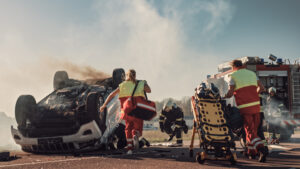Anterior Cruciate Ligament Injury (ACLI) usually happen from low-velocity, noncontact, deceleration injuries or from contact injuries with a rotational component. Some sports may also produce injury to the anterior cruciate ligament (ACL) secondary to twisting, valgus stress, or hyperextension all directly related to contact or collision.
We have all seen the signigicance of the ACL in athletes who require stability in running, cutting, and kicking. The ACL injury has also been linked to an increased rate of degenerative changes and meniscal injuries. For these reasons, between 60,000-75,000 ACL reconstructions are performed annually in the United States.
An estimated 200,000 ACL-related injuries occur annually in the United States, with approximately 95,000 ACL ruptures. Approximately 100,000 ACL reconstructions are performed each year. The incidence of ACL injury is higher in people who participate in high-risk sports such as basketball, football, skiing, and soccer. When the frequency of participation is considered, a higher prevalence of injury is actually seen more in women than men, at a rate 2.4-9.7 times greater for females.
History:
Most ACL injuries may be diagnosed through a careful history emphasizing mechanism of injury coupled with a good physical examination. A previous ligamentous injury may be the cause of instability. An audible pop often accompanies this injury, which often occurs while changing direction, cutting, or landing from a jump (usually a hyperextension/ pivot combination). Within a few hours, a large hemarthrosis develops. Patients usually are unable to return to play, secondary to pain, swelling, and instability or giving way of the knee. High energy traumatic injuries are often associated with other ligamentous and meniscal injuries. The classic “terrible triad” (ACL, MCL, and medial meniscus tears) involves a valgus stress to the knee with resultant acute injury to the ACL and MCL; however, the medial meniscus tear is now thought to occur later, as a result of chronic ACL deficiency.Physical:
An organized, systematic physical examination is imperative when examining any joint. Immediately after the acute injury, the physical examination may be very limited due to apprehension and guarding by the patient. The basic examination should include the following:
The examiner should begin with inspection, looking for any gross effusion or bony abnormality. An immediate effusion indicates significant intra-articular trauma. According to Noyes et al, in the absence of bony trauma, an immediate effusion is believed to have a 72% correlation with an ACL injury of some degree.
Assess the patient’s range of motion (ROM), especially looking for lack of complete extension, secondary to a possible bucket-handle meniscus tear or associated loose fragment.
Palpation of bony structures may suggest an associated tibial plateau fracture.
Palpation of the joint lines to evaluate a possible associated meniscus tear. Palpation over the collateral ligaments to suggest any possible injury (sprain) of these structures. Up to 50% of ACL ruptures have associated meniscal injuries; acute injuries are likely to have associated injuries of the MCL and meniscus.
Ligamentous laxity may be difficult to detect in the acute situation. The Lachman test is the most sensitive test for acute ACL rupture. Since the Lachman test must be performed when the patient is relaxed, it is often better to conduct this test prior to manipulating the painful knee.Lab and Imaging Studies:
Arthrocentesis is performed less frequently today because of the advent of other less invasive and more specific diagnostic tests, especially MRI. MRI has a sensitivity of 90-98% for ACL tears. MRI also may identify bone bruising, which is present in approximately 90% of ACL injuries.Treatment:
Before surgical treatment strengthening of the quadriceps and hamstrings, as well as ROM (range of motion) exercises is undertaken. Performance of ROM helps reduce the amount of effusion and regain motion and strength.
Generally, the recommendation is that surgical intervention be delayed at least 3 weeks following injury to prevent the complication of arthrofibrosis. The methods of surgical repair may be categorized into 3 groups, primary repair, extra- articular repair, and intra-articular repair. Primary repair is not recommended except for bony avulsions, which are mostly seen in adolescents. Because the ACL is intra- articular, the ligamentous ends are subjected to synovial fluid, which does not support ligamentous healing. Extra- articular repair generally involves a tenodesis of the iliotibial tract. This may prevent a pivot shift but has not been shown to decrease anterior tibial translation.
Intra-articular reconstruction of the ACL has become the criterion standard for treating ACL tears. Bone-patella-bone autografts are currently popular because they yield a significantly higher percentage of stable knees with a higher rate of return to preinjury sports. The major pitfall of these grafts is their association with postoperative anterior knee pain (10-40%). Hamstring tendon grafts are associated with a faster recovery and less anterior knee pain. Critics believe that these are more susceptible to graft elongation. Recent literature has supported a greater tensile strength with the use of braided quadruple hamstring grafts. However, this finding has not been confirmed in vivo, and the graft may be limited by the type of fixation.
Allografts have also been very popular because of their efficiency, their ability to provide bony fixation, and the lack of associated patella morbidity. However, they are associated with a risk of viral transmission. Allografts are best used in revisions. These have also fallen out of favor by some because several deaths linked to clostridial infections from inadequate sterilization techniques have been reported, which led to increased research into sterilization techniques to ensure safety. In addition, concerns exist regarding what effects the immunologic response and delayed revascularization and remodeling may have on clinical outcomes. Although allografts are generally accepted as having less associated morbidity, no proof of this is present in the literature.
Synthetic grafts and ligament augmentation devices have also been used. Synthetic grafts are no longer acceptable, because of their high rate of complications, including failure and aseptic effusions. Intra-articular reconstruction may be performed through a 2-incision technique or a single-incision endoscopic technique; the latter is currently more popular. This procedure requires graft stabilization with some type of fixation hardware for all of the graft options. The stabilization may be performed with metal interference screws, bioabsorbable screws, endobuttons, and cross pins. Each device has its own benefits.
Rehabilitation follows operative management. One special point is that the use of knee braces remains a highly controversial topic; braces are well accepted by patients, but most biomechanical studies do not support their use. Studies have shown that functional bracing can limit anterior translation of the tibia at low loads. Furthermore, most braces have been found to decrease the reaction time of the hamstring muscles.Other Treatment:
Nonoperative treatment may be considered in elderly patients or in less active athletes who may not be participating in any pivoting type of sports (e.g.: running, cycling). The goal is to obtain a full ROM and strength compared with the uninjured knee. This modality of treatment requires modification of activity levels and avoidance of physically demanding occupations. Arthroscopy may also be considered for persons who are poor candidates for reconstruction but have a mechanical block to ROM. The goal of this procedure is to debride the remaining stump to increase motion. Patients with significant arthritis are also thought to be poor candidates unless they are experiencing recurrent instability.Complications:
The current failure rate for ACL reconstruction is approximately 8%. The 3 major categories of failure in an ACL reconstruction are (1) arthrofibrosis (due to inflammation of the synovium and fat pad), (2) pain that limits motion, and (3) recurrent instability, secondary to significant laxity in the reconstructed ligament. These factors may be related to the surgical procedure (e.g.: malpositioned tibial or femoral tunnels, misplaced hardware, inadequate notchplasty).
Anterior placement of a tibial tunnel may result in graft impingement. If a tunnel is placed too posteriorly on the femoral side, the posterior cortex of the femur may be violated.
A graft also may fail due to a lack of incorporation, secondary to rejection or stress shielding.
Trauma from re-injury or aggressive rehabilitation also may cause graft failure. The incidence of graft re-rupture is approximately 2.5%.
Other complications include patella fractures and patella-tendon ruptures. Reflex sympathetic dystrophy, postoperative infection, and neurovascular complications are rare (each accounting for less than 1% of complications). The rate of postoperative deep venous thrombosis is approximately 0.12%.Prognosis:
Patients treated with surgical reconstruction of the ACL have long-term success rates of 82-95%. Recurrent instability and graft failure is seen in approximately 8% of patients. Knee scores of those treated nonoperatively have fair/poor results up to 50% of the time. As many as 40% of patients treated nonoperatively had no episodes of giving way. The knee scores in this group may be too sensitive, not accurately representing the clinical situation. Patients with ACL ruptures, even after successful reconstruction, are at risk for osteoarthrosis. The goal of surgery is to stabilize the knee, decrease the chance of future meniscal injury, and delay the arthritic process.Medical/Legal Concerns:
Medical/legal issues from ACL injury and graft replacement generally arise from complications during surgery. Initial misdiagnosis of ACL injury also can be a source of potential litigation. Obtain a complete history from the patient.
The mechanism of injury for ACL tear is fairly consistent. A thorough physical examination helps the physician confirm the diagnosis, and an MRI identifies additional possible injuries to other ligaments or cartilage.
Potential for a lawsuit arising from improper physical therapy also exists. If the therapist is too aggressive in rehabilitation exercises and rupture of the ACL graft occurs, some patients might consider litigation.













Comments for this article are closed.